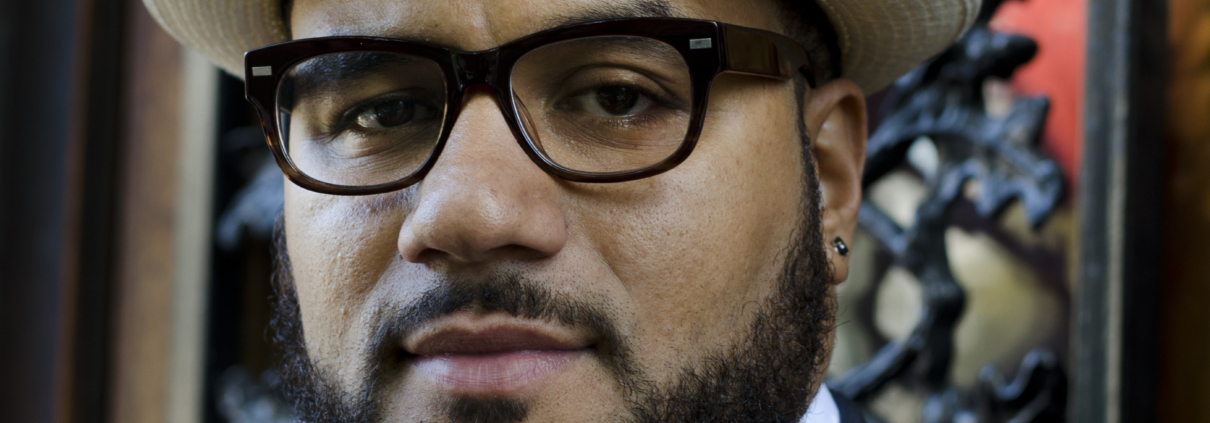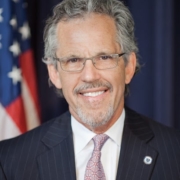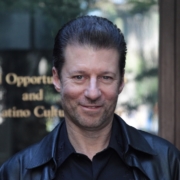Today we take a broad definition of education and explore the process of released prisoners re-integrating into American society.
My guest is CalvinJohn Smiley, an assistant professor at Hunter College, City University of New York. Calvin is currently co-editing a book with Keesha Middlemass entitled Prisoner Reentry in the 21st Century: Critical Perspectives of Returning Home, which will be published by Routledge.
In our conversation, Calvin puts prisoner reentry in a historical context and argues that the American prison system should not simply be reformed but must be abolished altogether.
Citation: Smiley, CalvinJohn, interview with Will Brehm, FreshEd, 104, podcast audio, February 18, 2018. https://www.freshedpodcast.com/smiley/
Transcript, Translation, Resources:
Will Brehm 1:11
CalvinJohn Smiley, welcome to FreshEd.
CalvinJohn Smiley 1:13
Thank you for having me. I appreciate you thinking about me and my work for this, Will.
Will Brehm 1:18
You have recently told me about this new edited collection that you’re putting together about prisoner reentry in the United States, and I want to talk about that. But before getting into it, I thought it would be good to just think about ‘What is the prison population even look like today in America?’ And ‘what is then prisoner reentry?’ So, can you give us a little context about prisons today? Like, how many people are actually in prison in America?
CalvinJohn Smiley 1:45
Yes. So, the United States has one of the largest prison populations in the world, one of the largest per capita. I think recently, the African nation of the Seychelles has taken over as the number one country of prisoners per capita. And that’s just because of its small population. I think I read something that they have like 17 people incarcerated. So anyway, when we think about it, the United States is the largest prison system per capita. At its zenith, the US had somewhere around 2.4 million people, and that was around 2008. Since that time, the numbers have dropped down a bit – some claims between 2.2 million and 2.3 million. What’s really interesting is that some academics and other researchers have said that the numbers actually haven’t fallen, but the way in which the justice system records their numbers have changed a bit. So, for instance, being in a detention center, as opposed to a prison, right? So, if you’re in a detention center before deportation, you’re not necessarily counted in that jail, imprisoned population. So, we have a lot of people incarcerated. That era, as many have said, started roughly in the late ’60s, early 1970s, basically under President Nixon, who had called for the war on drugs, and his “tough on crime” and no nonsense legislation, which is really a response to the civil rights movement and urban unrest. But all again coded language for “let’s attack liberals, leftists, and minority folks, particularly African Americans.” So, we see that that really manifested into a lot of legislation, both at the state and federal level. Things such as mandatory minimum sentences, meaning that judges … Basically mandatory minimum sentences took away judge’s right to use their own discretion, meaning that if you were caught with a certain amount of cocaine on you, or whatever drug substance, the judge had to sentence you based on the minimum guidelines. So, if that called for 20 years, regardless of your past criminal conviction, your job, your family, your whatever, you were sentenced to 20 years. There were also other things, such as truth in sentencing guidelines, which meant that certain folks had to serve a certain percentage of a particular sentence. So, in many states, it was 85%, meaning that if you were given a 10-year sentence, you had to serve at least eight and a half years before eligibility for parole. And also during that time, it wasn’t just Nixon, but we saw other presidents like Reagan, Bush, and Clinton also get on the bandwagon with this idea of tough on crime and passing a whole bunch of legislation that really ramped up local law enforcement as well as state and federal law enforcement to go after people to rid the communities of criminal or criminal behavior.
Will Brehm 5:19
Do you think under the Trump administration, you’ll see a rise again in the prison population, since Trump seems to be big on the war on drugs and the law and order sort of campaigning?
CalvinJohn Smiley 5:32
Yes, I mean it’s going to be interesting. I’ve been trying to follow as closely as I can, because not only just Trump, but our Attorney General Jeff Sessions. He is in a minority of politicians who actually believes that the war on drugs was working. When we think about the war on drugs today, there are people both on the Democratic and Republican side who have acknowledged that this war is not a winnable war, it is something that has not brought any type of diminishing in drug use across the country, and that people use drugs and we should really rethink our orientation towards what substance use legislation looks like. And you have states right now who are even legalizing certain substances, like marijuana, which is bringing revenue for those states in terms of taxes. What’s interesting, what’s happening now, is that numbers are still falling in terms of our prison system. But it’s too early to tell if this is a Trump thing. As the numbers are coming out, the numbers that are being reported are basically numbers that are being calculated still under the Obama administration. What we can say is that we see that the private prison industry and other industries that are tethered to the US criminal justice system have shot up in their stock. A lot of people are basically betting that the prisons will go back up. So, in short, we could see a potential rise in the US prison system under a Trump administration.
Will Brehm 7:19
And barring any changes in how they classify prison, right? Like you said earlier, prison or detention. That’s quite an interesting phenomenon. It depends how you classify what it means to be incarcerated.
CalvinJohn Smiley 7:35
Sure, and then you also see things like Chicago had a big exposé not too long ago, but lawyers were calling up the local precincts looking for their client and the local precincts were, “We don’t know where they are.” And they’re saying, “Well, they’re in your custody.” And they basically exposed that Chicago had these kind of black site jails, where they were holding people and not telling their family, their lawyers. So if we also fold those into the mix, and I’m sure Chicago is not the anomaly here, but I’m sure that there are many cities and places around the country as the United States has had black sites around the world of these kind of detention centers and prisons. And Donald Trump has expressed his willingness to bring these black sites back in terms of interrogation and the war on terror.
Will Brehm 8:30
It does seem like the war on terror that America has been supposedly fighting since 2003. It seems like a lot of it is actually returning home, like you said, is returning back into the US where they are, I think there’s so many pictures of these protests lately, where police in basically military gear walking down the streets of America. And then what you just said about these black sites, prison black sites in Chicago, which is something that seems to be a legacy of this war on terror. So, it really does seem like there is somehow this legacy of the war is actually now coming back home into America.
CalvinJohn Smiley 9:17
Sure. When we look at the United States, we have this real fondness to use the word “war”, whether it’s war on terror, war on drugs, war on crime, war on gangs, war on poverty. So, we’ve this constant need to have an adversary. But what’s really interesting about the idea of the war on terror is, it’s an abstract. The war on drugs, while not necessarily an abstract, it definitely has certain implications of the war on which drugs. So we’ve now seen that for the past 40 years, the war on crack cocaine, the war on heroin, meant criminal sanctions, meaning that if you were caught with a bundle of heroin, a couple ounces of heroin, you were going to jail. And that was mainly being thrown at African Americans and other minorities living in urban centers. But now what we’re seeing is this incredible shift in policy in terms of how we’re treating heroin users. Now, it’s no longer being seen as a criminal justice issue, but seen as a public health issue. But what has also changed is the hue of the person that is being seen as the user. So, in the 1980s, when the user was seen as this kind of Willie Horton, this kind of menacing black man image, it was lock them up and throw away the key. But now that it’s Becky from the suburbs, the United States is now trying to articulate that we need to help these people. And the outgoing Governor of New Jersey Governor Chris Christie had this whole campaign to combat opioids. And we’ve now also seen that the US government knew that pharmacies were pumping out opiates and doctors were prescribing these pills when people probably didn’t need them, knew that they were highly addictive, and the result is that we now have an opiate epidemic across the country. And it’s not just in the urban centers, but it’s across America, hitting suburbs, hitting college, educated, middle class, white folks, and this is something that we now need to deal with.
Will Brehm 11:32
But the language isn’t “war on opioids”?
CalvinJohn Smiley 11:34
No, it’s “save our children” and “save our families”, and the language has changed. And it’s interesting how that change is really manifested in coded language around race, and class.
Will Brehm 11:54
It seems like a lot of this is the legacy of slavery that America just has never been able to deal with, and they just keep changing these terms to talk about these new phenomena.
CalvinJohn Smiley 12:07
And some have even reported that, while the United States is in some ways, lowering, say, or decriminalizing or making marijuana legal, there’s a trade-off because what we’re also seeing is in other crimes, sentencing actually going up and longer punitive sentencing. So, this is kind of the tradeoff. So even when we think about in the last year of Obama, he really made mass incarceration, or tackling the idea of mass incarceration kind of a priority. And he is one of the highest, if not the highest, of commuting people in federal prison. But you remember, it was a very specific group of people: nonviolent drug offenders who were not connected to any kind of violence, gangs, other potentially previous offenses. And unfortunately, that’s hard to find. If you’re in the drug business, if you’re in the drug trade, there’s other factors that go into that. That’s other criminal elements, there’s crime, there’s violence, there’s all these different things. So, Obama was finding the unicorns, and people were rallying around these unicorns. And we can say that mother who got caught up because she was trying to feed her children, and she sold crack cocaine, and she’s now done 15 years of her life in a prison, that is an abomination of justice. And then a lot of people get behind that narrative. What we’re less likely to get behind is the narrative of people who have committed violent crimes, people have committed crimes that we see as either taboo or majorly deviant, such as child molestation, rape, assault, murder, we haven’t tackled, “How do we bring those folks back into the fold if we really want to have a justice system that is restorative rather than punitive?”
Will Brehm 14:18
So, let’s turn to this reentry of prisoners into American society. What actually currently happens when a prisoner is released from prison?
CalvinJohn Smiley 14:33
Before I answer that directly, let me just say, really prior to the early 2000s, the academic research really wasn’t focusing on reentry; it was focusing, relevantly so, on mass incarceration, this kind of throwing massive amounts of people into the US prison system. And then in the year 2000, and Jeremy Travis wrote this really great article, which manifests into a book called ‘But They All Come Back’, and what he points out, or what he highlights, is that roughly 95% of all people who go into American prisons or jails come out of those places. So, we really need to start tackling this issue of, “What are the resources? What are the advising? What are the other kind of networks that we, as an American society, are going to put together to make this coming back really work?” And so, people really started to look at reentry more fully in the early 2000s. Then in 2010, the US prison releases exceeded prison admissions for the first time since the Bureau of Justice Statistics began collecting that data in 1977. So, in other words, more people came out of a prison than went in. So, this really started making people aware of this idea of reentry, because it put a sore on this problem that America hadn’t dealt with that, we really were doing “lock’em up and throw away the key and forget about them.” But what started to happen was through sentencing reforms, through the fact that some people were literally just coming to the end of their mandatory sentence, so if you had gotten 20, 30 years in the late ’80s, early ’90s, by 2010 you’ve served your 20 years, now you’re coming out. So not only do we have people who’ve served all this time, but we also have an aging population that’s coming out of prison that I think a lot of people don’t think about. That there are people coming out of prison who’ve been there 20, 30 years and are now 50, 60 years old. So not only do they need resources and other kind of help that the average person needs, but they also need some other things that elderly folks need.
Will Brehm 16:58
So, when this aging group of people reenter society, do people get jobs? Do they go back to school? What does life actually look like?
CalvinJohn Smiley 17:15
It’s hard. It’s hard. The majority of my research is around prisoner reentry, so I spent three years working in a community-based reentry organization in Newark, New Jersey where men and women would leave prison. At the time, the majority of those folks who I worked with and met with were living in a halfway house – and I can speak a little bit more about a halfway house in a moment, what those places are and what they do and how they function – and coming to this center for help and for assistance. It’s a complicated answer, there’s no simple answer, because what we see in the United States is, we have literally 50 different prison systems, because prisons are state run facilities, and we have a federal system. And even within the federal system, there’s then the military thing. So, there’s all of these different bureaucratic apparatuses that are operating that dictate what you can and cannot have. And then even furthermore, there’s individual prisons that some are better, and some are worse. So, for instance, in New York State, Otisville Corrections Facility has programs galore; there’s programs, everything from a prison puppy program to literally students can get college credits through CUNY, through the Prison-to-College Pipeline program, and everything in between. And so, if you are incarcerated at that facility, you might actually have more social capital, cultural capital, upon release. If you’re in a prison that doesn’t provide these things, then it might be that much harder. So yeah, the short answer is that it depends where you’re incarcerated, it depends on your social networks of family, friends and other networks of folks that might be able to assist you in terms of putting money on your commissary so that you don’t have to worry about the day to day kind of “Do I have a toothbrush? Do I have toilet paper?”, and also, can folks also hold your stuff? Because I think that’s something that my research also touches upon is that a lot of research that’s out there about reentry focuses on this idea of success, and what is successful reentry. And while people talk about success, it’s really a nuanced word in the sense that it’s really an individualized word. So, for the state, one might argue that success for the state is that you don’t come back. For a for-profit prison, success might be that you do come back. For an individual, and something that I found that I thought was really interesting was, I ran a group while I was working at this facility and I’d always start the group with what I thought was a corny icebreaker every week, and people would have to say their name and they’d have to say one positive thing that’s happened in their week. And a lot of guys would say something like, “I’m alive”, or “I woke up this morning”. And in the beginning, I always thought that was a dismissive answer, just my own not understanding reentry as well as I did. And then as I got to know these guys, to say that I woke up or I’m alive today, that was a really profound and powerful thing for these guys. Coming out of a really hostile, violent environment, to be able to wake up, put your clothes on, come to this place, not be harassed by the police, not have anything go wrong, that really meant something for them. And that was success. Every day was a success. So, there’s a lot going on with reentry. And I think one of the things that a lot of people forget, as I started to mention earlier, is what kind of social network, family, friends you have, because when you go to jail, your apartment doesn’t wait for you, time doesn’t wait for you, the things that you own don’t say, “Okay, when you get out, we’ll be here waiting.” So, for many guys, men and women, the loss of not just the abstract, such as social relationships with family, friends, but also the actual tangible things that we need. So, your license, your social security card, your birth certificate, your clothing, all of those things can be lost. So for anyone who wants to get a job … in the literature of reentry, two of the most fundamental things that scholars say that folks need to reenter society is that they need number one: stable housing, and number two: employment, stable employment. Well, I would say I agree with that, but if you don’t have an ID or a birth certificate or a passport, or any kind of validating information outside of your state issued prison number, it is very hard to secure housing, it’s very hard to secure employment. So, there’s very immediate steps that are needed before we can even get to the conversation of well, how do you now stay out? It’s really, how do we begin?
Will Brehm 22:53
How do we begin? How do prisoners get ID cards? How do they get their birth certificates which had been lost? How does that actually happen?
CalvinJohn Smiley 23:03
Bureaucratic tape. You have to go down to City Records. I remember, one young lady had informed me that she was having a lot of trouble getting her birth certificate because she didn’t know what hospital she was born in. And no one knew, it was just this very confusing time. So, proving her own existence, really, her only form of identification was her rap sheet, was her prison jacket. So that was a very frustrating thing, and this was a young lady who wanted to go on to get her GED, she wanted to enroll in college. It just makes those tasks that much more difficult to attain.
Will Brehm 23:54
And so, the state doesn’t actually help ex-prisoners go through that process of obtaining the necessary? It seems so basic, like you said, for so many additional things you would have to go and do.
CalvinJohn Smiley 24:11
So, the state, no. But depending on where you live, there might be or might not be more assistance. So for instance, in the city of Newark, the city of Newark actually has its own Reentry Division within City Hall, so a lot of folks can go down there to City Hall, tell them what they may or may not need, and then City Hall is supposed to then refer them to the different places. There’s what’s called One Stop, where people can go to try to access these materials, there’s places like where I worked at, that City Hall will refer people to, and there’s other kind of nonprofits and other organizations such as Dress for Success, soup kitchens, etc., etc. But it’s deeper than that, because we’re also dealing with a population that has, for many of them, has physical traumas, mental traumas, they might have emotional disturbance issues. So, we’re not talking about a population that is ready and able to just do everything for themselves, especially since our prison system is designed that they cannot do anything for themselves. So, the reorientation becomes much more difficult. And that doesn’t necessarily mean I’m taking agency away from people, but just think about the practicality that if you went to prison in say 1995 and you are not getting out till 2015, just think about the technological advances that have shifted. I remember one guy telling me he literally had a freak out on the bus, and that’s because he was getting on the bus assuming that he was going to drop some coins, like a token, into it. And this was a swipe card, and he didn’t know it, the bus driver obviously didn’t know his story, and the bus driver doesn’t have time to explain this, people behind him. So, he said he literally had to get off the bus and wait, and then figure it out. So, we’re talking about literally plucking people out of society, and then just literally dropping them back in and saying, “Do it”. And that becomes a really, really hard thing, and not only just do it, but now you have to do it even better because you’re on either parole, probation, some other form of criminal supervision which now can limit a whole host of things, which I can get into if you’d like, some of the limitations that folks have.
Will Brehm 26:46
Yes, one of the ideas that you wrote about – and I think you wrote about this in your PhD thesis – is on what you called “neo-civic death”, and I’d like to talk a little bit about what you mean by that term, because I found it very fascinating.
CalvinJohn Smiley 27:03
Yes, so civil death is a term that’s really old, it dates back to Rome and Greece and things like that and it basically was to be an outlaw, to be outside of the law. So if you commit a certain type of crime, literally you would be considered no longer part of the Republic, and therefore your civil citizenry was no longer existent, which then meant that your physical existence could be in jeopardy, because that would mean that someone could kill you with impunity. So I’ve updated the term a bit, because the term is really interesting, so coming out of Rome, Greece, it then found its way into medieval times, and then to English common law, and then obviously, the United States with its English ancestry. Civil death had made its way at least in legal citations and things like that. But I updated it because I think that it’s more nuanced today, in the sense that obviously, citizens aren’t able to kill other citizens with impunity. If we went into law enforcement, how they use their kind of things, that might be a different thing. But I situate the term in this idea that American persons who’ve been incarcerated, they really fall into what I consider this limbo state in what I identify as having almost a purgatory citizenry, which is this neo-civil death, because on one hand, you’re still an ingroup, the country cannot kick you out. Some people have asked me why don’t I look at undocumented persons in terms of my research on reentry, and the main reason is that if you’re an undocumented person, you’re most likely going to be deported; you’re going to be deported back to your own country, and that comes with a whole set of issues and problems, and I know folks who’ve written on that and continue to write on that idea of what deportation looks like. But it doesn’t necessarily fall into the realm of reentry and how I’m looking at it. But on the other hand, you’re an outgroup, because you are not given the same kind of civic and civil responsibilities as persons without a felony. So, this could mean anything from loss of legal rights; political rights, such as voting, serving on juries, potentially holding public office; economic rights, such as holding certain employment; social rights, in terms of housing. If you live in New York City and you have a felony, you cannot live in any of New York City public housing. Now, does that mean that in all of New York City public housing, there’s no one who’s ever been to jail living in that? Of course, there are. So what that means is people are living in a heightened sense of fear that if the police ever come and do a stop and frisk, arrest them, or whatever, they could be in violation of their parole, probation, or whatever form of criminal justice supervision that they’re under. One of the things that I find to be the most fascinating and interesting forms of neo-civil death is that for many folks who have been incarcerated, one of the stipulations for parole, and/or if they’re on probation is that they cannot associate with other known felons. Well, there’s a lot of discretion in that. So, for instance, you can be standing on a street corner waiting for the light to change and another person can be also be standing there waiting for the light to change. The police wants to stop and frisk you, ask for your ID, ask for the other person’s ID, and you come back that you’re on parole, and they come back as on probation, the police officer has it within their right to say, “These two individuals were fraternizing.” And therefore, you’re in violation of your parole, because you were associating with other known felons. Now they might take you down to the local precinct jail, they might book you, run your stuff, they might call your parole officer. And of course, as we know, in most cases, your parole officer isn’t going to drop everything that they’re doing to come down and assess the situation. So, you might be sitting in that precinct jail for an hour, eight hours, whatever the case might be. And even if it is all worked out that they don’t charge you with anything and the parole officer comes down and says no, if you are on your way with your job application for a job and that other person was on their way to pick up their daughter from daycare, that’s gone now. Those hours are gone. And it’s very hard to explain to a potential job. “Hey, I got rearrested because of my background.” So, when we think about this idea of how known felons and this idea of what is a “known felon”, places in New York City like Brownsville, sections of Brooklyn, overwhelmingly young African American men are on parole, probation or some other form of supervision. So basically, what this does is it limits one’s mobility. It takes away one’s first amendment rights, free access to assembly. And I’ve talked to guys who have told me that they’d love to go to a Black Lives Matter’s rally or something like that, but if the police start to get to arresting and they get arrested and someone else in that crowd gets arrested, that could be considered fraternizing with other known felons. And so, what we’re seeing is how the state manipulates one’s ability to be a citizen.
Will Brehm 32:44
So, at what level is the activism taking place that is trying to change this incredible system of reentry? I think this idea of where you just get plucked out of society, and then just popped back in is a pretty good metaphor of thinking how this is actually happening, and how it creates so many perverse scenarios as you’ve been describing. So where is the movement for change here? Is it happening in these local communities, or at the state level? Or is it at the federal level? Where do you see change happening, or where do you think change should happen?
CalvinJohn Smiley 33:28
Well, it’s got to happen at all levels. It’s got to happen at the federal, state, local, grassroots. In terms of what individuals are doing, I see it as two different camps. One camp is very much on reform, and one is on abolition. So, the reform is really looking at how do we create legislation that makes the prison experience less damaging? And then there’s the other camp that says, “No, this system does not work. We need to completely get rid of it and think about something in a much more egalitarian, restorative and 21st century way.” One thing that I think a lot of people don’t realize is that in the scheme of human history, prisons are actually very new, at least in the way that we think about them – that prison became the punishment. Prior to really the late 17, early 1800s, the dungeon was only a holding place till they drawed and quartered you or cut off your head or something. So, when prisons were really developed in the way that we think of them now, they were actually seen as really progressive. That this idea that penitentiary, the root word “penance”: that one would go in to a prison, reflect, think about what they did wrong, pray to Jesus, Jesus would absolve them of their sins and they’d come out and be better individuals. Well, we know that over time, putting human beings into very small confined areas doesn’t do anything for their both mental, physical health. So, there are organizations that are out there. One that I can think of is #cut50. And this is operated by Van Jones, who’s on, I think, CNN, and he’s written a book called ‘Green Collar Economy’, really sharp guy. And part of his initiative, which he’s also partnered with people like Newt Gingrich, the former republican Speaker of the House, who was part of the mass incarceration era of legislation. But their goal is to cut the US prison system in half within 10 years. So cut50, cut 50%. There are other local organizations that I know of that are Incarcerated Nation, I believe it’s called. I’m forgetting the exact name, but really, advocates to get rid of solitary confinement. So, you know, solitary confinement is used at the discretion of the jail or the prison. Human Rights, the UN has said that any more than 14 days of solitary confinement is inhumane, cruel and unusual punishment. We have an eighth amendment that addresses that. Neurologists and other folks who study the brain have shown that after 14, 15 days of solitary confinement, the brain literally starts to deteriorate, not just that people are seeing apparitions and hearing voices, but literally the brain starts to physically deteriorate. So, you have places like Rikers Island here in New York City that can hold someone in solitary confinement for up to 90 days. And then the kicker here is that on that 91st day, they can take you out and then put you right back in because it’s a new clock. So, when we start to see people like Kalief Browder, who was the African American young man who was held at Rikers for a little over three years, and the majority of that time was held in solitary confinement. This is how they operate.
Will Brehm 37:08
So, do you do you fall into the reform camp or the abolition camp?
CalvinJohn Smiley 37:13
I fall into the abolition camp. I’m a prison abolitionist. I believe wholeheartedly that the US or that prisons in general, but US prison particular has not done what they claim it’s supposed to do. We still have very high recidivism rates; around 67% of people who are incarcerated are rearrested within three years. Many times, those arrests are on technical violations. I knew a gentleman who was in a federal halfway house who was coming consistently to my group that I was running, and he disappeared for about three months. And when he came back, I said to him, “Where did you go?” He said, “Well, I was sent back to federal prison because I had a cigarette.” And so, I questioned, “What did that mean?” And he had said, “Well, in the federal halfway houses, tobacco is not allowed.” And he was a smoker, he had some cigarettes, and he had left a cigarette in his front pocket when he came back and they gave him a pat down. They found the one cigarette and like he told me, “I told the CO he could have the cigarette; I don’t care about it.” But the guy decided to use this as an opportunity, and he spent three months in a medium security federal prison in Pennsylvania for one Marlboro Red, or menthol or whatever it was. So this is what folks are dealing with, and not just from the moral and the ethical reasons of why prisons are really terrible, violent places that don’t do anything, but when we start to look at it from just a purely economic sense, they are money gouges. They are huge black holes of state budgets that could go into education, that could go into roads, that can go into houses, medicine, technology, and other infrastructures that could clearly and definitely help build up communities because we know that incarceration isn’t a broad spectrum of Americans. It is a very specific group. I believe Hagan wrote an article and had shown that in New York state prisons, over 70% of prisoners in New York state prisons came from seven neighborhoods in New York City. So, we’re not incarcerating individuals, we’re incarcerating entire communities. We’re not incarcerating one person; we’re incarcerating an entire family. As they talked about intergenerational wealth, intergenerational poverty, we’re now starting to see intergenerational incarceration. Where fathers, sons, grandfathers, uncles, cousins, they’re all incarcerated. So, we need to break that up. One other thing I wanted to mention was folks like Jay Z have really stepped up in terms of trying to combat mass incarceration. And one thing that Jay Z has also brought up is that the bail system in the United States is really a poor man’s nemesis. Because if you cannot afford bail, you sit in a jail awaiting trial. And that’s something that a lot of people don’t realize. Most people in American jails, because there is a distinction between jail and prison: Prisons are typically state run, and they’re usually for folks who have been convicted and typically convicted for more than one year. Jails are typically county or city run, and they’re typically for pending trial or for people who’ve been convicted for something that gives them less than one year of a sentence. So, when we look at places like Rikers Island, the majority of people who are at Rikers Island are people who are pending trial, they could not afford bail. So, this whole idea about bail reform, and for some folks, we’re not even talking about millions of dollars. In the case of Khalif Browder, his bail was set at $3,000 and his family couldn’t afford that. So, we’re talking about abject poverty meeting the criminal justice system, and this is something that definitely needs to not only be reformed but needs to be replaced.
Will Brehm 41:32
Well, CalvinJohn Smiley, thank you so much for joining FreshEd. It was a pleasure to talk.
CalvinJohn Smiley 41:36
I appreciate you having me, Will, and I hope we can do it again in the future.
Prisoner Re-entry in the USA









